As we all know, feeding our dogs isn’t the most difficult task in owning a pet, however, doing it consistently right is, but how does a Vizsla feeding chart help?
Well, much like any other one, the Vizsla feeding chart helps owners have a quick reference guide on how many calories their doggo should be consuming at any given stage of his life, though this one is specific to this wonderful Hungarian canine.
Though, do keep in mind that the same rules won’t apply to every dog, you’ll still need to do a little bit of trial and error yourself to keep your precious pooch in adequate shape and not let him go under or overweight.
This means that proper portioning is going to be a must as will be his choice of food, the former of which the chart normally covers, but some factors may influence it too and have it shift, like various diseases and other health issues.
As for the latter, much like humans, you can’t feed your dog anything and expect it to meet their daily nutritional requirements alongside their caloric intake. High quality dry dog food will be needed.
Thankfully, we’re not strapped for choice in that regard, but finding the right one may be difficult.
To find out what exactly this feeding chart looks like as well as the many factors that will influence it and the answers to some of the more commonly asked questions, do be sure to read on.
The Vizsla Feeding Chart
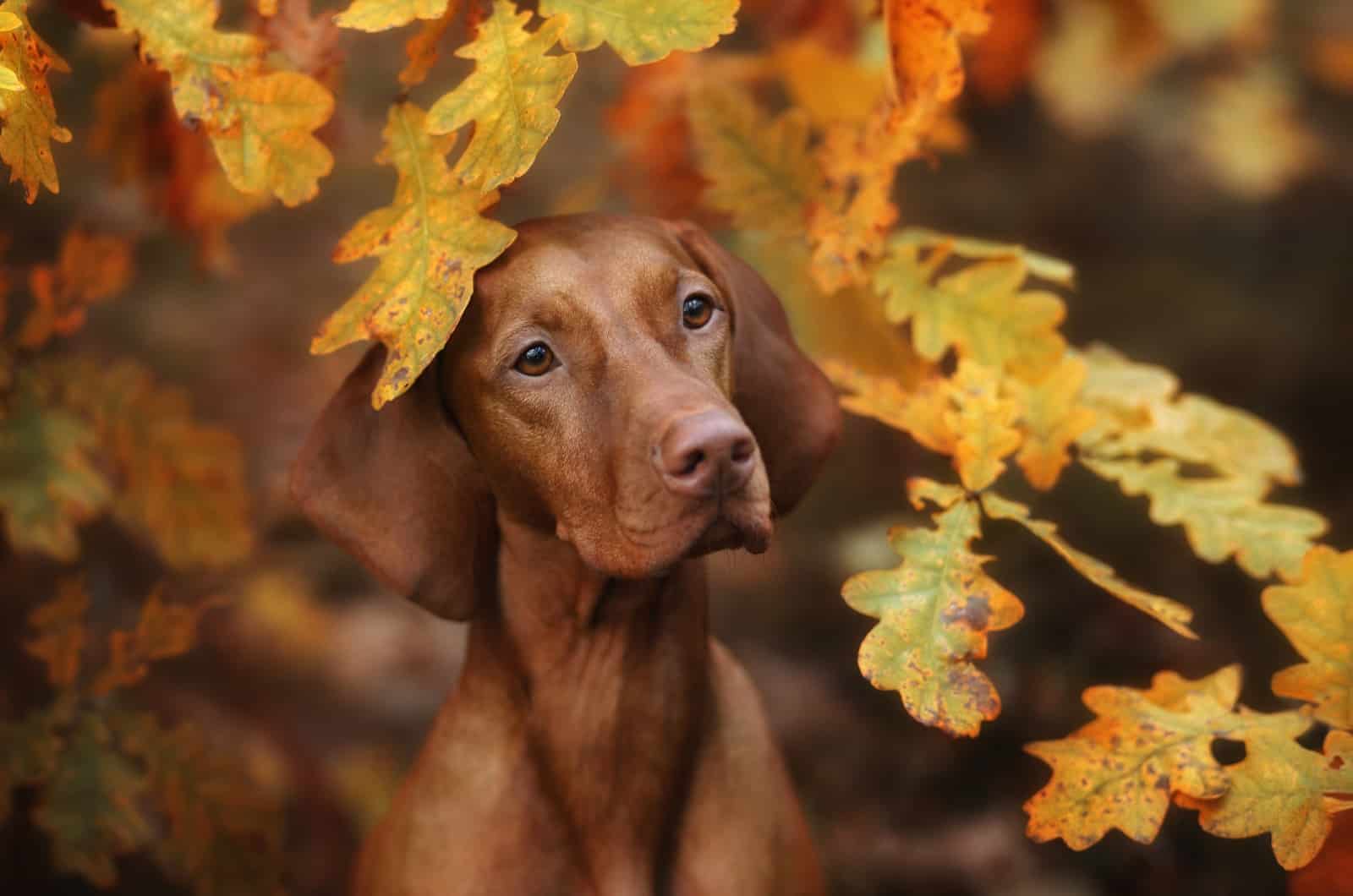
The best way to figure out how big your Vizsla should be is by following a weight or feeding chart of which the standard one looks something like this:
[table id=746 /]
As you can see from the chart above, the growth of a Vizsla for dog owners isn’t all too hectic, it’s the part prior to the acquisition that has a pretty rapid growth in the amount of food needed daily, the part that the breeders need to take care of that is.
The estimated weight itself doesn’t go through any major spikes either and stays relatively constant with a gradual decline as the dog reaches adulthood.
As far as portions go, that usually depends on the dog. While most other places will recommend 2-3 servings a day, it can be different depending on your Vizsla’s metabolism overall, though somewhere around that mark is usually the average.
If anything, I’d recommend going for more, smaller portions rather than less and bigger as it helps teach your dog how to pace himself to prevent potential issues down the line like bloat that can be caused by greedy eating.
But what does this all look like and what do our dogs eat as they grow? Well, here’s a brief synopsis of his first year of life before he becomes an adult dog.
0-2 Weeks Of Age
When he’s just a little pup who was barely born, he won’t be able to move around much, and likely won’t be moving away from his mother either, in which case she’ll be the one handling the feeding part mostly.
Though, you’ll be handling the feeding of the mom which boils down to free feeding in most cases.
Your doggo will be on mother’s milk for this period, and, if, for whatever reason, his mother rejects him, it’s then that you’ll have to step in to simulate his mother’s embrace.
This is usually done through the use of a heating pad and a milk replacement alternative that’ll be bottle fed to simulate sucking on a nipple.
Some breeders cover the pad in something similar to the texture of his mother’s fur and even put a ticking clock under it to simulate the heartbeat, but both of these are optional.
The reason why is so that the pup more readily accepts the given food, to trick him into thinking it came from his mother.
3-4 Weeks Of Age
By this point, the Vizsla puppy would gain a little bit of autonomy and would be waddling around the place, exploring his surroundings and getting better acquainted with them, though he’ll still be almost exclusively feeding off his mother’s milk.
That said, by the tail end of this period, you’re expected to attempt weaning your pupper off of mother’s milk and onto more solid food to make it easier for him to adjust to his new surroundings once he’s rehomed.
Sometimes it won’t work, but you should keep trying every now and then because it needs to be done by week 8 as that’s normally the period in which dogs get handed over to their new owners.
It’s better to attempt swapping him over to dry dog food in smaller batches.
The doggo is likely to only need about a cup of high quality dry dog food daily in terms of nutrients, and it’s best spread out around 4 portions to prevent overfeeding during a particular session.
Also, don’t make the transition right away, it’s better to do it gradually by slowly mixing the dry dog food in with water to help him get used to the new texture and gradually changing the ratios around until it’s predominantly kibble and little to no water.
It’s an old trick that breeders use, one that still works to this day and shows the best results when needing to swap a dog over from one dog food brand to another.
5-6 Weeks Of Age
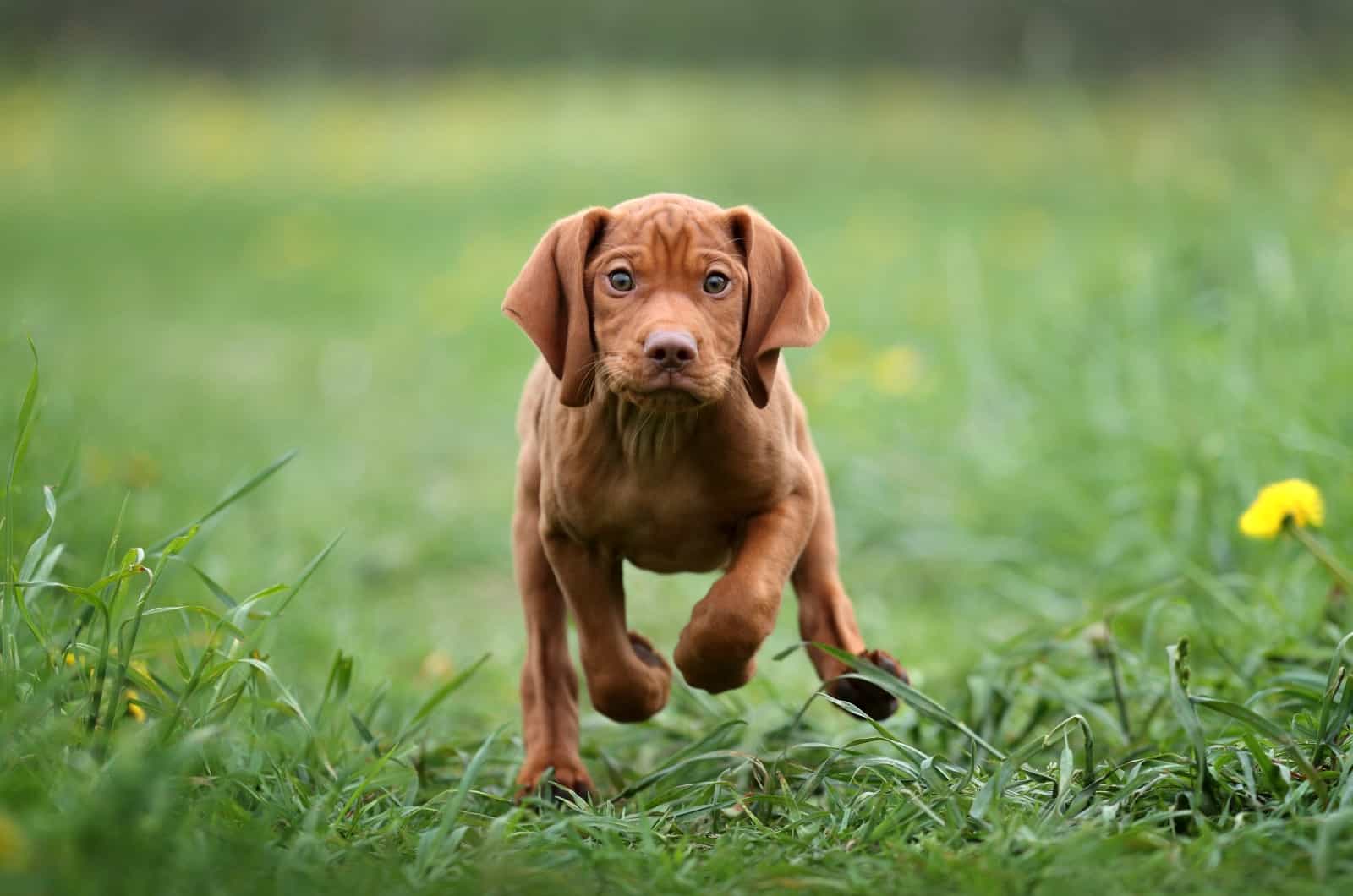
Remember what I said about rapid spikes in the pre 8 week period? Well, you’ll already be upping your dog’s daily intake by about 50%, adding an extra half a cup of food to help keep up with his initial rapid growth.
However, not all dogs grow at the same rate, so it’s best to gradually introduce the extra food in rather than shoving in an extra half cup all at once, to help him adjust better, much like we did with the water trick.
There will be a bit of trial and error, sure, but you’ll eventually get to a point where your dog will be enjoying his food without risk of obesity or malnourishment.
Just be sure to pay attention to his weight gain over this period and adjust accordingly.
If yours is still stuck on the mother’s milk, now is high time to be more persistent about the fact as it will cause problems for the owners later down the line.
Somewhere nearing the end of week 6 is also when you should be looking into giving him some basic obedience training so he doesn’t cause much trouble for the new owners, or you, depending on who’s getting him.
7-8 Weeks Of Age
This is the final stretch of your puppy’s initial period before he gets rehomed and the very last chance you have to wean him off it and get him onto solid foods as he won’t have access to the former when he gets a new owner.
You should also continually add to his daily food intake, capping out at around 2 cups a day with 3-4 portions, once again, depending on his preferences.
Other than that, make sure he continues his behavior training until he gets at least a basic understanding of everything as well as a good amount of physical training, and he should be good to go.
9-10 Weeks Of Age
At this point is usually when a new Vizsla owner starts being considered in these feeding methods, unless you’re both breeder and owner, in which case you better look at everything from the start.
In any case, you’ll want to ask the breeder what brand of dog food your dog is eating, just so you don’t end up buying Purina while he ate Royal Canin prior or something similar.
This can end up with him straight up rejecting food as it’s still something he’s not used to and you likely won’t have enough authority over him yet to convince him otherwise.
If you want to swap him over to a different type of food, you’ll need to employ that water trick from earlier to help him slowly transition, especially if he’s being fighty about it.
Though, do keep in mind what food you’re putting him on and adjust portion size and amount accordingly to not end up with an over or underweight dog. After all, a balanced diet is the key to a long life.
We’re also still continuing with that rapid growth spurt that happens early on in a Vizsla’s life and you’ll be upping his daily food intake to around 2 and a half cups by the tail end of this period.
Up To 3 Months Of Age

Not much else changes here aside from the final rapid increase in his daily food requirements, going up to around 3 cups when he reaches his third month and the rapid growth spurt finally starts receding.
It’s also recommended to lower the portion sizes to around 3 per day now, but if your doggo fares better with 4, then it’s up to you to decide.
Just keep in mind that the smaller the portion sizes, the less energy he’ll have for physical exercise.
Expect the food amount to not increase much for the rest of his first year of life, or at least not as quickly.
Do keep in mind to keep him in shape though so the dog’s weight doesn’t end up becoming a burden right away.
And, of course, continue the behavioral training that the breeder should’ve started so he can adjust to you being his new owner and friend more easily.
3-4 Months Of Age
Some Vizslas may still see a little bit of growth in this period and it may warrant an increase of around a quarter cup to his daily intake of food, but usually it still stays at around the same.
This, however, is an ideal period for your dog to become a bit more social, get out in the world and hang out and play with dogs, and kids alike so that he knows how to behave around them when he’s older.
5-8 Months Of Age
Again, not much will happen around this period aside from it being the next stepping stone in upping the amount of food he’ll be consuming daily as he continues growing to his adult size at a steady pace.
Keep feeding him high quality food and be wary of his food sensitivities if he has shown signs of any.
You’ll be upping his food by another quarter of a cup, equaling to around 3 and a half cups at this point, give or take a few depending on your dog.
9-11 Months Of Age
Your dog is reaching the final stretch of the major part of his growth and he’ll need adequate sustenance of good quality dog food that you’ve been feeding him thus far, increased to around 3 and 3/4 of a cup.
Other than that, things mostly remain the same. Once that initial growth spurt finishes, things thankfully end up being rather routine after that.
First Year Of Age
It’s somewhere around month 12 that the Vizsla is going to reach adulthood and finish with his growth.
The average Vizsla at this stage consumes around 4 cups of food a day to help keep up with his high energy lifestyle.
Do make sure to move him over from puppy kibble to adult dog food as there are significant differences between the two, especially in the protein to fat ratio.
Year 1 To Year 8
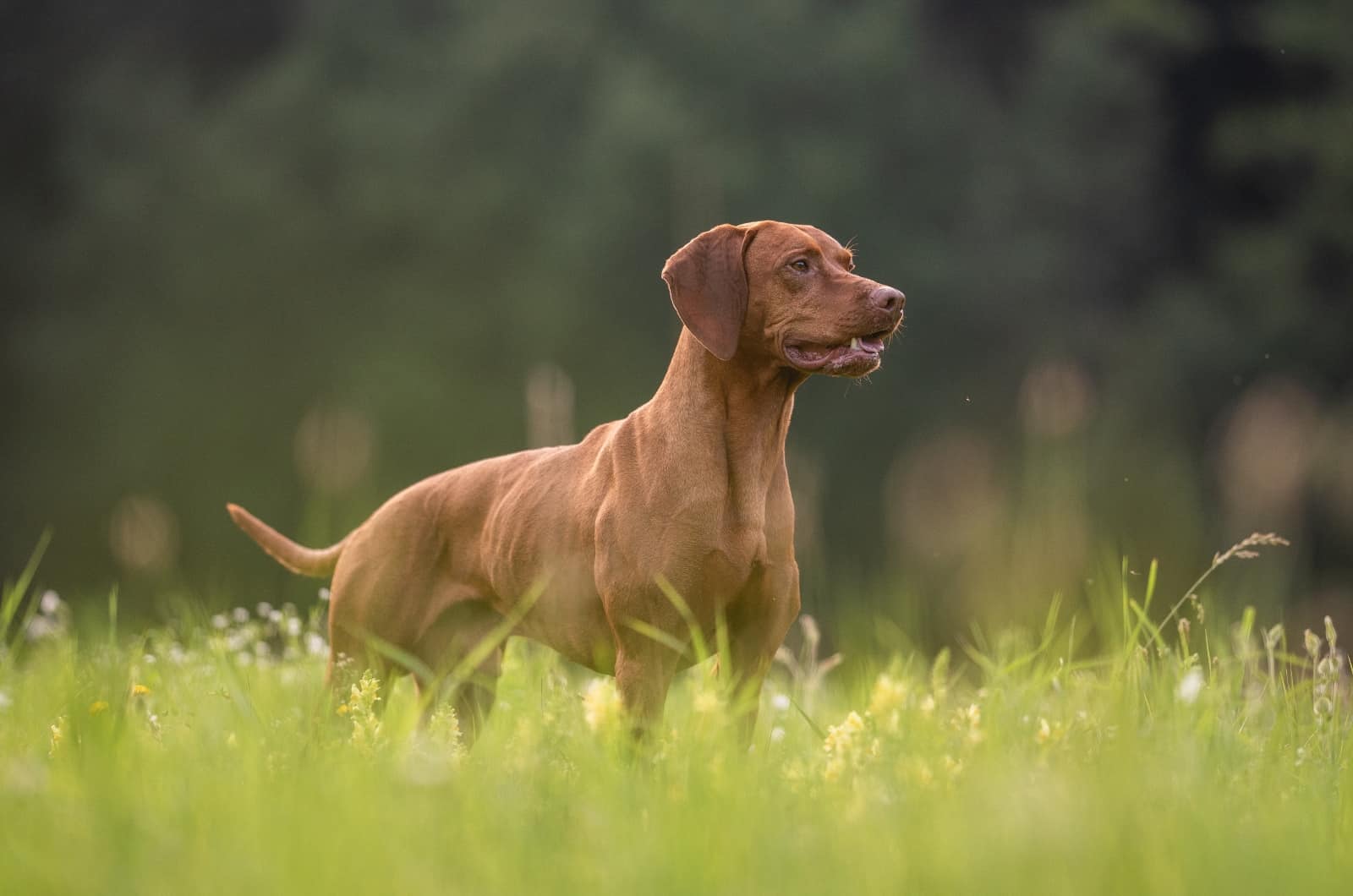
This is considered to be the adult life stage and is likely the calmest period of this lovely and energetic family dog.
By calm I mean that you won’t really need to do many changes to his diet outside of any uncontrollable factors like various health conditions that’d impact the Vizsla’s diet or illnesses and the like.
It’ll be smooth sailing up until year 7 or 8, depending on your dog’s metabolism before it starts to gradually slow down as age catches up to him.
The closer he gets to it, the more food he’s likely to need, but this can be monitored easily and adjusted by you.
If you notice him gaining a pound or two extra, then be sure to slightly reduce his food intake to make up for the metabolic deceleration.
Year 8 And Onward
At around year 7 or 8, your Vizsla enters his senior years and is likely to become a bit less active depending on the potential health issues that may pop up during this period, mainly revolving around their bones given their size and shape.
As far as food is concerned, you may end up going down to as low as 3 cups if need be, depending on his age and maybe even swapping over to dog food better suited for senior dogs.
One that’s chewy and easier to digest so his metabolism doesn’t need to put in as much work.
Given how they’re one of the healthiest dog breeds on average, they’ll still end up living to around year 13 or so, giving you plenty of time to care for this old rascal.
What Major Factors Impact A Vizsla’s Weight?
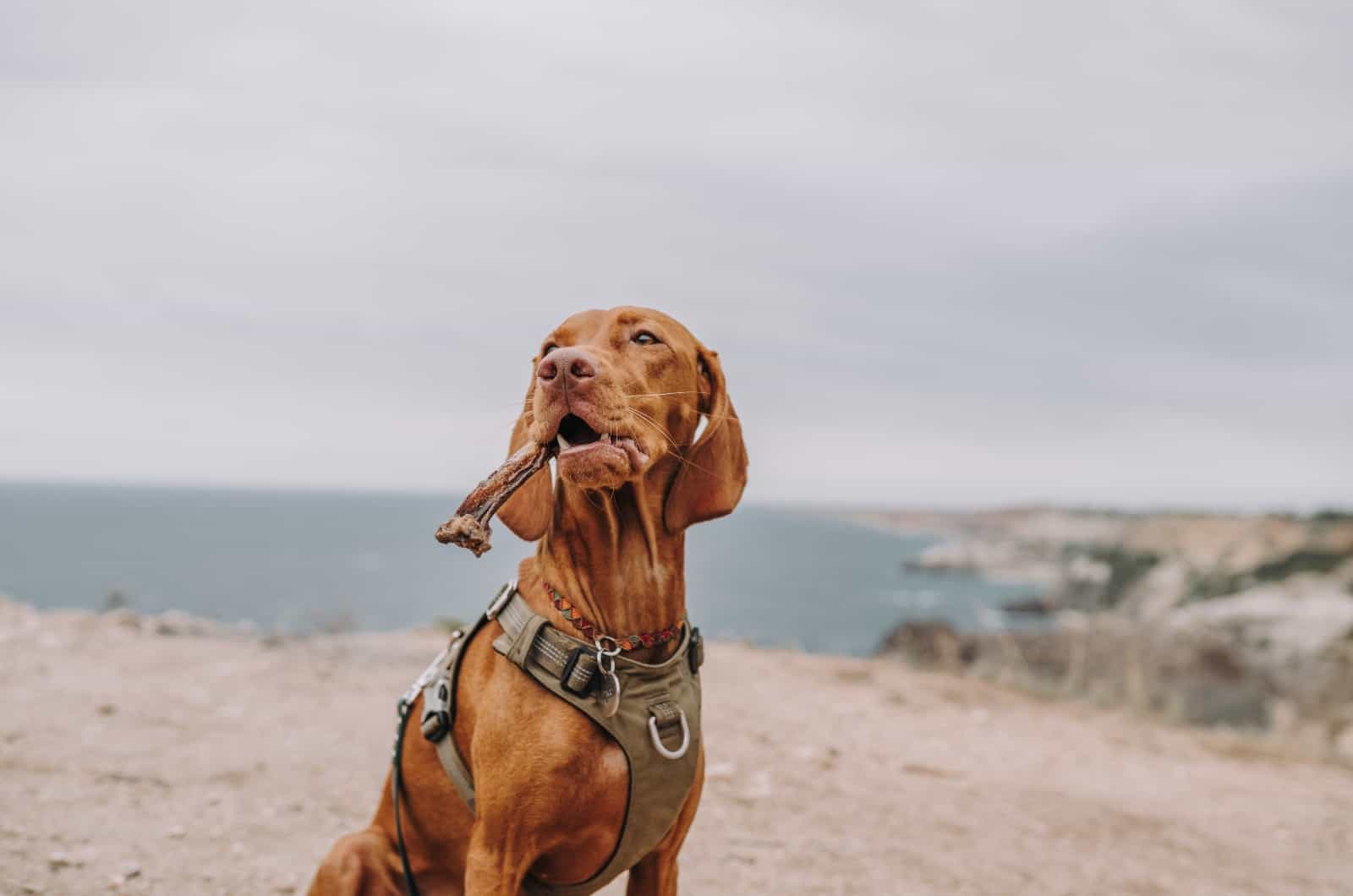
There are a few major contributing factors that will impact a dog’s weight and that aren’t mutually exclusive to any one breed.
Keep in mind that the ones about to be mentioned aren’t the only possible factors and that there are some breed-specific ones to keep in mind.
The main ones are as follows:
1. Genetics
As it is with every dog breed, one of the main factors impacting a Vizsla’s diet tends to revolve around genetics.
They’re the building blocks of all living things after all and dictate a lot of our features.
In dogs it’s anything from fur growth, overall body growth, the effectiveness of the dog’s metabolism as well as resistance to disease and other health issues.
And, at least for now, it’s something we can’t really do much about aside from treating the conditions that stem from this problem as they come.
Some are treatable, some less so, but all of them require some form of dietary and lifestyle adjustment, especially when it comes to food allergies or sensitive stomachs in general, the times where you have to ditch an entire protein due to a sensitivity.
2. What He Eats
The second major contributing factor is going to be his diet.
It’s easy to generalize the best food to be high quality dry dog food, but that isn’t really going to help too much as there’s plenty of variety to go around.
That’s also why using cups of food as a measure doesn’t really work out all too well given the different amount of caloric content per volume in different food options which is why I keep insisting you adjust depending on your dog’s weight gain or loss.
Now, given the size of the Vizsla, a few pounds above the recommended line won’t really affect him too negatively, but try to keep it in line with the median if you can.
That said, I’d still rather consult with a veterinarian or a pet nutritionist to get a more accurate measurement of what the average for your dog would be and what constitutes a healthy weight for him.
As for what is actually healthy, there are a few things to keep in mind, especially for pups:
Quality Protein
A good protein is the foundation of every piece of dog food and chicken and beef tend to be the best ones to go for with the other alternatives being that of turkey, lamb or fish.
Fiber
Something to make all that protein go down smoother is always good to have paired with it, a source of fiber, be it rice, sweet potatoes, peas or similar.
A Healthy Protein To Fat Ratio
You’ll also want around a 25% protein and 15% fat ratio in his food ideally, though you can deviate on this one as long as the ratios remain relatively similar.
Make sure to avoid fillers as they’re often just empty calories as well as some common allergens like corn, soy and wheat in your dog’s food if he’s having sensitivity issues.
Omega 3 Fatty Acids
Other than that, you’ll want to make sure that the food contains omega-3 and 6 fatty acids which help keep your dog’s fur nice and shiny and improve your dog’s overall immune system.
Probiotics
Speaking of which, a healthy batch of probiotics and prebiotic fiber is always welcome as it helps foster the growth of healthy gut bacteria which are responsible for digestion and a more responsive and healthier immune system.
Aside from that, you’ll want a healthy dose of vitamins in there, as per usual, to help with overall growth.
DHA and EPA
DHA and EPA are particularly important in puppies as they help develop and maintain their cognitive skills.
Calcium And Phosphorus
Calcium and phosphorus are important too as they help with proper bone and cartilage growth.
Glucosamine And Chondroitin
Aside from those, you also want to include a healthy dose of chondroitin and glucosamine which help maintain bone and joint health, particularly crucial in any medium or large breed dogs given their back problems later on in life.
Of course, that’s the ideal scenario, not everyone is going to be able to find the food that ticks all the boxes, but try getting as close as you can to it.
3. His Level Of Exercise
Finally, the last one that’s equally as logical is your dog’s activity level.
It determines how healthy he’s going to be as it’s the best method of building muscle and burning calories and weight along with it.
Now, Vizsla dogs require a lot more exercise than the average dog given their extremely high energy levels, an astonishing two hours of at least medium levels of it a day, including play and walkies.
It may sound like a lot, but a Vizsla is a pretty physically intensive dog, which is also why they tend to stay relatively healthy and don’t really dip into obesity that often regardless of the dog’s age.
How Big Does A Vizsla Get?
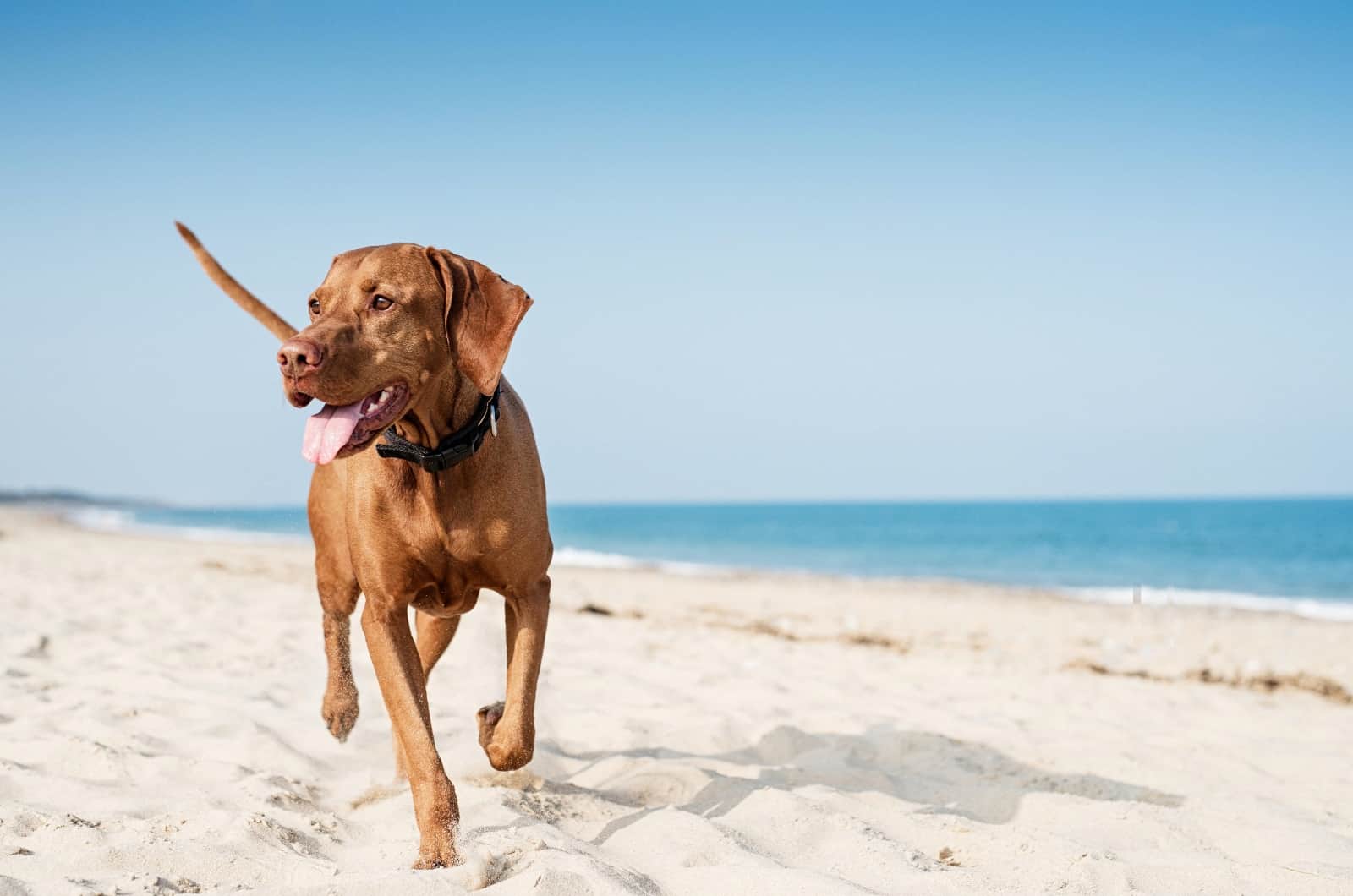
Vizslas are considered to be a medium to large dog breed, bordering between the two.
Height wise, they end up somewhere around 23-ish inches, give or take an inch, and they end up weighing an average of around 55 lbs with the heaviest ones going all the way up to 65 lbs.
And don’t be fooled, most of this is going to be muscle, making them appear lean with a larger chest.
FAQs
Which Is Better For A Vizsla’s Diet: Dry Or Wet Dog Food?
A question that’s commonly asked with a relatively simple answer.
While wet dog food is juicier and offers more flavor, it’s not better because of it.
It’s great to serve as a treat every now and then, but not as a consistent diet as it tends to be bad for the dog’s teeth, staining them and affecting their overall quality.
Dry dog food on the other hand usually helps clean teeth given its shape and texture and is often more nutritious.
This isn’t even mentioning the price tags which dry kibble wins out on too given the manufacturing processes that come into play for both sides.
My personal recommendation would be to stick to the dry stuff as the main source of nutrition while dog treats and wet dog food remain only that, treats.
If you want to soften your dog’s food or make the dry stuff into something wetter, you can always use bone broth as a form of sauce to provide it with more flavor on top of all that, and it’s healthy too.
What About A Raw Diet?
While raw diets are becoming some sort of modern craze, I personally believe it to be tripe for a good number of dog breeds.
Sure, there are benefits to the diet itself, what with eliminating carbohydrates from the equation to help improve digestion as well as the overall customizability, but all of that takes away your other resources, those being time and money.
Preparing the food takes a while, and it tends to be real pricey, so dog owners on a budget won’t be particularly keen on the option.
Plus, my biggest gripe with raw food diets is the fact that they’re an open invitation to disease and parasites to a degree, something I’d rather not expose my own dog to if I can avoid it.
On top of all that, kibble has most of its nutrients ready to go whereas with the raw variant, you’d have to construct all of that yourself which, once again, is going to be time consuming, and it doesn’t guarantee that you’ll be able to find what you need.
Supplements can cover that, but at that point, you may as well stick to the dry stuff as I guarantee that your dog will be combative over anything that looks remotely medicinal.
How Much Should I Feed My Vizsla?
Once again, that wholly depends on your dog’s habits.
The average tends to be anywhere from 2 to 4 times a day depending on his age with the larger number of portions being tied to Vizsla pups, while the smaller amount of portions is tied to senior Vizslas.
As long as you keep it to a strict feeding schedule and don’t veer off of it every day, your dog should be fine regardless, however, I do advise you to consult your local vet or pet nutritionist on the matter regardless.
They’ll be able to give you more concrete instruction as they can check into your dog’s medical records and construct a proper feeding plan.
When Should I Swap From Puppy Food To Adult Food?
Once again, it depends on your dog, but normally the swap happens around month 8 to month 12, the earlier being the average point at which a Vizsla is considered an adult as his growth slows down dramatically afterwards and caps out at around the first year.
The swap should happen similar to the water trick with you gradually mixing more and more of the adult food into the puppy stuff until he gets used to it entirely, after which you can cut him off the former.
The same method works for older dogs in case you’re looking to transition to food more adequate for senior dogs.
What Are Some Common Health Concerns Regarding Vizslas?
While they do stay relatively healthy, there are a few concerns that you should be wary of.
Hip And Elbow Dysplasia
Hip and elbow dysplasia are the major ones regarding their bones, ones that most medium and large dog breeds tend to suffer from, particularly at later life stages.
A condition that can’t really be treated once it happens, but can be alleviated through medicine and lifestyle changes, and one that can be prevented through healthy dieting and exercise.
Bloat
The second on the list is bloat, a particularly heinous issue that’s often brought upon by either overeating or eating too quickly in dogs.
A problem that occurs when the stomach distends to fit in a larger amount of food only to twist around itself when retracting back, trapping the contents of the stomach inside it as well as cutting off blood flow to neighboring organs.
As you can tell, this can get real bad, real fast, which is why your dog is going to need immediate veterinary help in reversing the problem.
A good preventative measure is to teach your dog how to pace himself while eating to minimize the chances of this issue happening in the first place.
Parasites
The other of the three major issues related to dieting, parasites often end up in your dog’s system through the ingestion of raw, uncooked food or through eating something random off the street.
The most common parasites are tapeworms, ringworms and hookworms.
They all act functionally the same, draining the nutrients from the ingested food and keeping it for themselves, leaving the host malnourished.
Should your dog be affected early on in life, it can end up causing some permanent damage to him, which is why frequent deworming treatments are recommended during the puppy period, once every two months or so, even if test results show otherwise.
Other Issues
These aren’t the only problems that can plague Vizslas, but the others aren’t really brought upon dieting.
That said, be on the lookout for progressive retinal atrophy, tricuspid valve dysplasia and epileptic attacks in particular as those are some of the more major concerns for Vizsla dogs.
What’s The Expected Lifespan Of A Vizsla?
Given how healthy they are, most Vizsla dogs end up on the higher end of the medium dog lifespan spectrum, reaching anywhere from 12 to 15 years with 13 being the average, potentially prolonged with good genes and healthier diets.
In Conclusion

The Vizsla Feeding chart shows us what the averages for this wonderful breed are meant to be throughout its various life stages, but do keep in mind that these are all mostly estimates based on collected data.
Your dog may veer off the expected average due to a number of factors and that’s perfectly fine, just be sure to consult with your local vet in order to adapt your pet’s diet accordingly.
Hopefully this helps you improve the quality of life for your furry friend. Until next time, pet parents.
RELATED LINKS:
- Wirehaired Vizsla Breeders In The U.S.: Get Your Dog From ‘Em
- 8 Vizsla Colors With Pictures: Choose Your Favorite
- 27 Least Aggressive Dog Breeds: Drumroll Please
- 15 Best Tall Skinny Dog Breeds – Let The Runway Begin
- 37 Cool Dog Breeds – The Coolest Dogs For The Coolest Owners
- 40 Low-Maintenance Dogs That Are Everything You Need
- 36 Bird Hunting Dog Breeds: Set, Flush, Point, Retrieve
